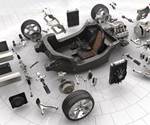How to patch a racecar
The current state of the art in automotive CFRP repair borrows heavily from experiences gained in the aerospace/aviation and racing fields.
The current state of the art in automotive CFRP repair borrows heavily from experiences gained in the aerospace/aviation and racing fields. This repair was made to a car owned by the Swiss Formula 1 race team, Sauber (circa. July 1997).
Step 1
Damage (white scars/scuffs) sustained by Formula 1 car when wheel was pushed into the CFRP chassis during brush with a wall during a race.
Step 2
Outer skin and core removed from damaged area. Outer skin is chamfered with a 30-mm/1.2-inch wide beveled edge prior to being joined to patch.
Step 3
Repair patch is a precured outer skin with honeycomb that will be bonded in with a paste adhesive.
Step 4
Repair patch is a precured outer skin with honeycomb that will be bonded in with a paste adhesive.
Related Content
-
Performance resins, putties and structural adhesives
CAMX 2025: Scott Bader illustrates its local and global materials supply availability backed by technical support, as well as a novel composite panels development with Armacell.
-
Composite, adhesive and core solutions focus on performance, reducing carbon footprint
JEC World 2025: Gurit celebrates 190 years with a display of its product variety — from Spabond 400, resins, prepregs and Gurit PET to BalsaFlex, Opticore and other core systems.
-
Henkel releases digital tool for end-to-end product transparency
Quick and comprehensive carbon footprint reporting for about 58,000 of Henkel’s adhesives, sealants and functional coatings has been certified by TÜV Rheinland.
.jpg;width=70;height=70;mode=crop)





